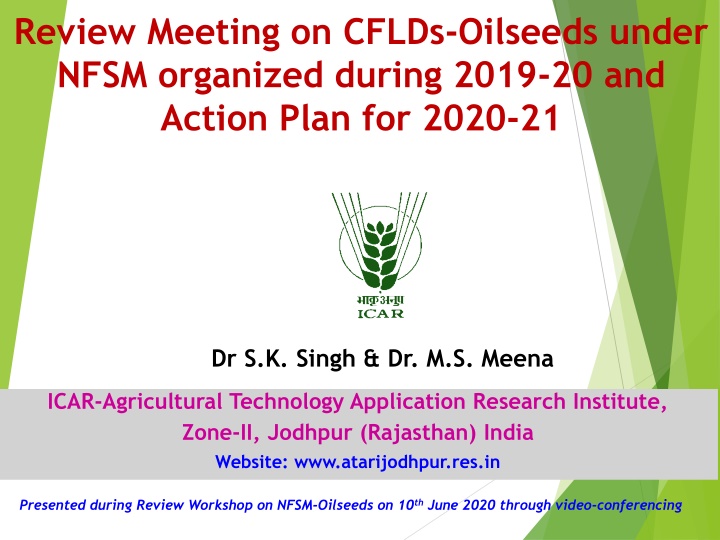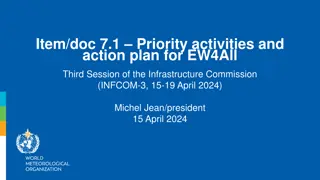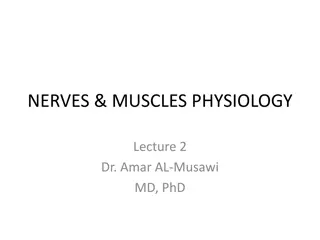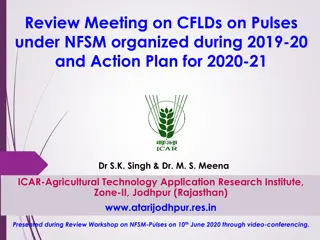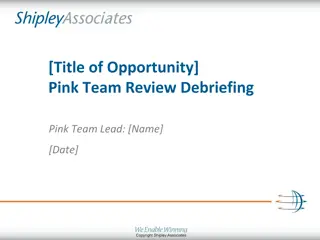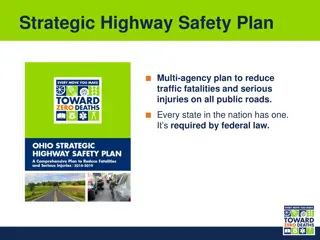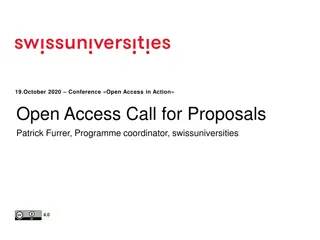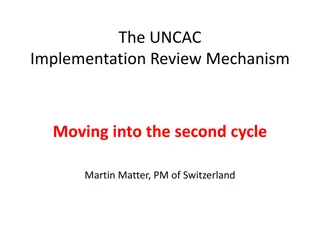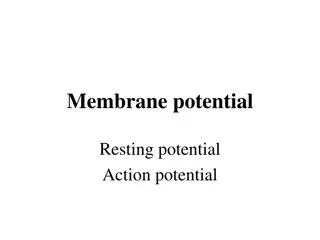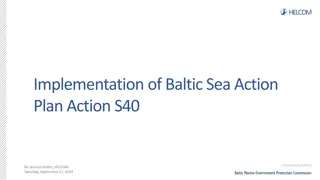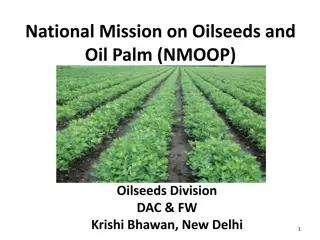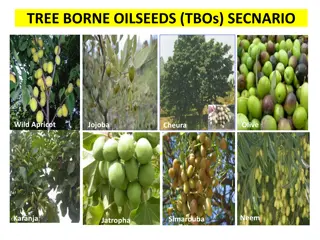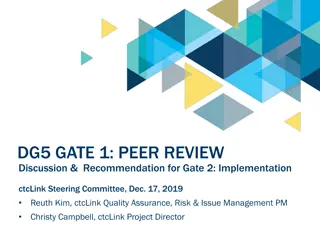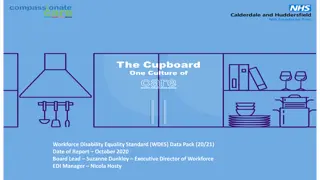Review of CFLDs-Oilseeds under NFSM and Action Plan for 2020-21
Dr. S.K. Singh and Dr. M.S. Meena from ICAR-ATARI discussed the review meeting on CFLDs-Oilseeds under NFSM organized in 2019-20 and presented the action plan for 2020-21 during a workshop. The meeting highlighted major initiatives, targets, achievements, state-wise yield gaps between CFLDs and farmer practices, and the annual action plan for CFLDs-Oilseeds in 2020-21. Key points include the determination of technological packages, participatory planning, involvement of KVKs, challenges faced, and more.
Download Presentation

Please find below an Image/Link to download the presentation.
The content on the website is provided AS IS for your information and personal use only. It may not be sold, licensed, or shared on other websites without obtaining consent from the author.If you encounter any issues during the download, it is possible that the publisher has removed the file from their server.
You are allowed to download the files provided on this website for personal or commercial use, subject to the condition that they are used lawfully. All files are the property of their respective owners.
The content on the website is provided AS IS for your information and personal use only. It may not be sold, licensed, or shared on other websites without obtaining consent from the author.
E N D
Presentation Transcript
Review Meeting on CFLDs-Oilseeds under NFSM organized during 2019-20 and Action Plan for 2020-21 Dr S.K. Singh & Dr. M.S. Meena ICAR-Agricultural Technology Application Research Institute, Zone-II, Jodhpur (Rajasthan) India Website: www.atarijodhpur.res.in Presented during Review Workshop on NFSM-Oilseeds on 10th June 2020 through video-conferencing
Major Initiatives/issues 1. Situation specific technological packages are determined based on gap analysis between existing & recommended practices. 2. Critical inputs are decided/rationalized as per financial norm in each crop. 3. Critical practices are demonstrated as per demand and applicability under different Farming Situations. 4. Participatory planning, execution, monitoring and evaluation is done by KVK/ATARI. 5. Farmers contribution is ensured for participatory CFLDs in mustard, groundnut, soybean and sesame. 6. Involvement of SMSs of Agronomy, Plant Protection, Agriculture Extension and Home Scientist in finalization of technological packages, execution, monitoring & evaluation of CFLDs. 7. Majority of KVKs of Rajasthan have initiated to mobilize farmers to keep as seed of produce under CFLDs for next year (Farmer-Farmer diffusion) and large scale multiplication. 8. Orobanche weed is managed by glyphosate, now banned by GOI, hence efforts should be done by DRMR, Bharatpur to manage this weed. 9. Change in annual plan, lack of timely release of fund and no provision of fund for monitoring/field visits by KVKs/ATARI hinders effective implementation of CFLDs.
Targets & Achievements of CFLDs on NFSM-Oilseeds during 2019-20 Targets Achievements State Crop Area (ha) Total CFLDs Area (ha) Total CFLDs Groundnut Soybean Sesame Mustard 170 90 170 3800 4230 60 1920 1980 110 110 6320 425 225 425 9500 10575 150 4800 4950 275 275 15800 285.3 60 172 3750 4267.3 70 1900 1970 100 100 6337.3 724 145 415 9375 10659 152 4750 4902 250 250 15811 Rajasthan Total Sesame Mustard Haryana Total Mustard Delhi Total Grand Total
State wise & crop wise yield gap between CFLDs, farmer practice, state & national average yields (2019-20) Yield gap between CFLDs yield & Farmers practice (q/ha) (6)=(3-4) 4.17 2.45 1.35 3.96 0.83 2.95 Yield gap between CFLDs yield & State avg. yield (q/ha) Farmers practice (q/ha) #State average yield (q/ha) *National average yield (q/ha) CFLDs yield (q/ha) State (s) Crops (1) (2) (3) 24.76 12.21 4.96 19.12 4.23 20.10 (4) 20.59 9.76 3.61 15.16 3.40 17.15 (5) 21.31 4.59 3.28 16.56 6.71 20.58 (6) 18.68 10.49 4.78 13.97 4.78 13.97 (7)=(3-5) 3.45 7.62 1.68 2.56 -2.48 0.48 Groundnut Soybean Sesame Mustard Sesame Mustard Rajasthan Haryana Note: Low yield in Soybean crop due to heavy rainfall in Kota region during Kharif-2019. # State Agricultural Department *Source: Directorate of Economics and Statistics
Annual Action Plan of CFLDs-Oilseeds for 2020-21 Sl. No. Crop (s) Rajasthan Haryana Delhi Total Area (ha) Total CFLDs Area (ha) Total CFLDs Area (ha) Total CFLDs Area (ha) Total CFLDs 1 Groundnut 1010 2525 - - - - 1010 2525 2 Soybean 690 1725 - - - - 690 1725 3 Sesame 1200 3000 150 375 - - 1350 3375 4 Mustard 3170 7925 1510 3775 50 125 4730 7780 11825 19450 Total 6070 15175 1660 4150 50 125 Implementing KVKs: Rajasthan; 44 Haryana = 18; Delhi=1 Total: 63
Technology to be demonstrated under CFLDs on Oilseeds-2020-21 Based on the gap assessment in existing & recommended practices Crop Varieties Seed treatment Weed Management Fertilizer Management Insect pest and Disease Kharif-2020 GG 20, RG 510, HNG 123, HNG 10, HNG 69, TG 37 A, GG 2, GJG 22 RT-351, RT 346, GT 3 Groundnut Thiram or Mancozeb (3g/kg of kernel) or Carbendazim (2g/kg kernel) Alachlor or Fluchloralin @ 1.5 kg a.i./ha (Pre-showing), Pendimethalin @ 1.0 kg a.i./ha (pre-emergence) N: P: K, 40:40:60 kg/ha as basal, Apply Borax @ 10.0 Kg/ha as basal, Gypsum @ 200 Kg/ha at pegging stage Insect: White grub, Leaf miner and Aphid Disease: Early leaf spot, tikka and collar rot Sesame Thiram or Mancozeb @ 2.5g/kg seed Basalin @ 1.0 kg a.i./ha or pendimethalin @ 1.0 kg/ha as pre- emergence treatment N: P: K, 20:10:10 (rainfed) Manganese sulphate @ 5.0 Kg/ha as basal N: P: K, 20:60:20 kg/ha 20 Kg/ha Sulphur Insect: Leaf roller, Gall fly and Hairy caterpillar. Diseases: Bacterial blight, Phyllody & stem Insect: Hairy caterpillar, Girdle Beetle, white fly. Diseases: Bacterial blight, yellow mosaic virus Soybean JS-20-29, JS 95-60, RKS 24 Thiram or Mancozeb (3g/kg seed) or Carbendazim (2g/kg seed) Pre-emergence application of 30EC 1.25 kg a.i./ha pendimethaline in 600- 700 liter of water and post-emergence application of Imazethapyr 10.E.C. 1.0 liter solution in 700-750 litter water/ha Rabi-2020-21 For Orobanche, spray the soil with 0.25% copper sulphate (Drenching) or 50 ml Glyphosate/ha Mustard DRMRIJ 31, NRCHB 101, NRCDR 2, RH 725, RH 749, RH 406, PM 26, PM 28, CS 58 Thiram or Mancozeb (3g/kg seed or Carbendazim (2g/kg seed) N: P: K: 60:40:40 kg/ha (irrigated) Aphid is major insect. Alternaria blight, white rust, downy mildew are major diseases 40:20:20 kg/ha (unirrigated), Pre-emergence application of Fluchloralin @ 1.25 kg/ha 20-25 kg/ha Sulphur * Cost of Chemical fertilizers has been invested by farmers themselves.
Budget Utilized during 2019-20 Opening balance as on 1.4.2019 Fund received during 20219- 20 Total fund available during 2019- 20 Expenditure during 2019-20 Closing balance as on 31.3.2020 1.93 lakh 1.68 crore 1.70 crore 1.31 crore 38.57 Lakh
